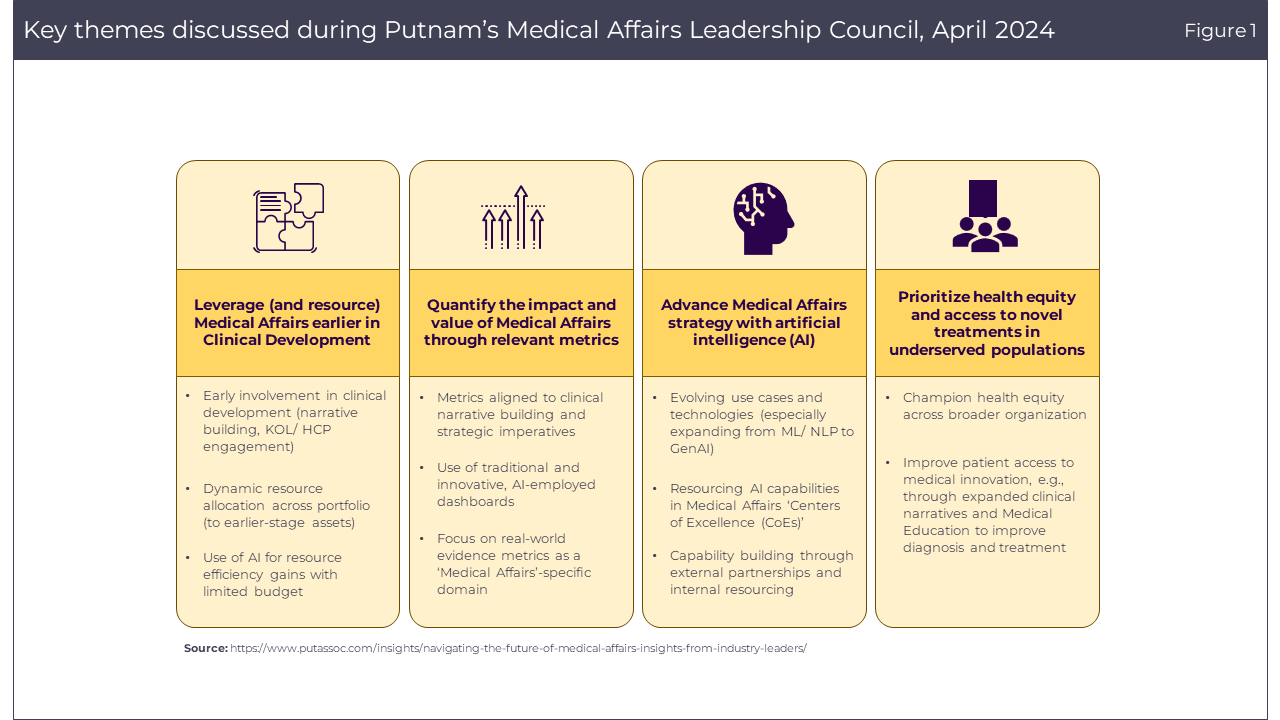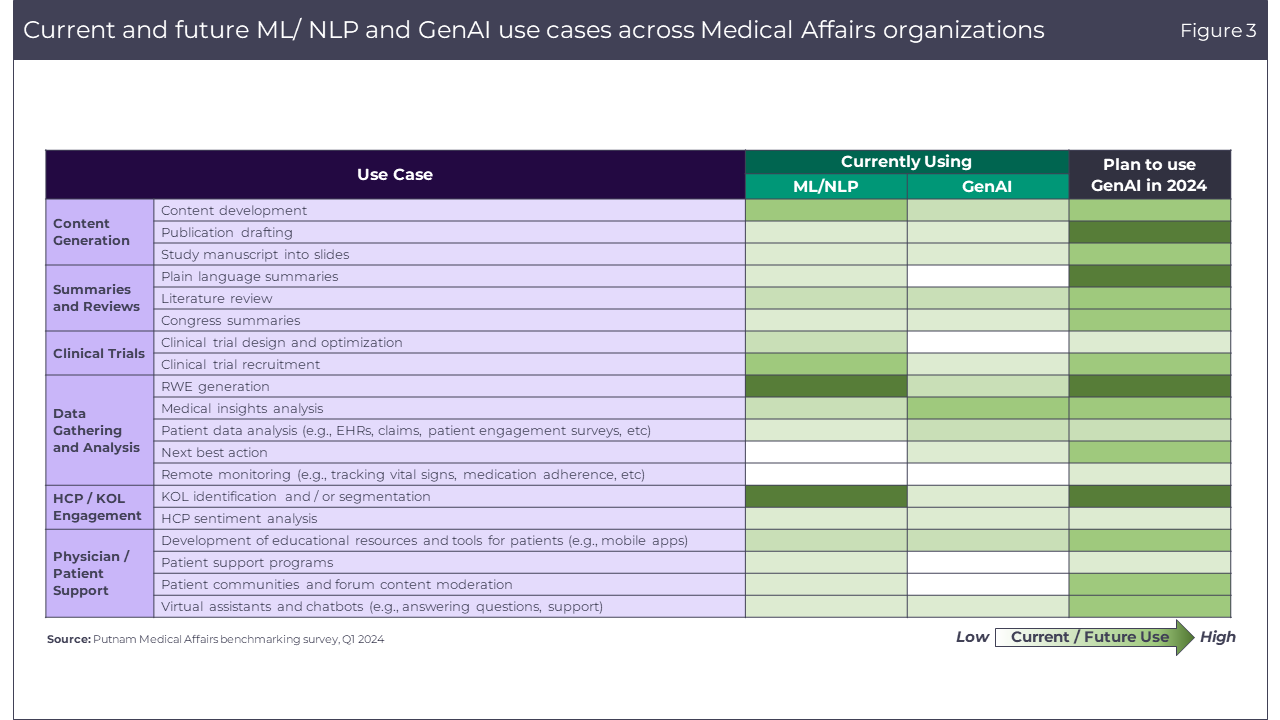Leading world-class Medical Affairs into the future: Insights from Putnam’s Medical Affairs Leadership Council (Spring 2024)
Putnam recently reconvened our Medical Affairs Leadership Council. Bringing together Chief Medical Officers and Heads of Medical Affairs from large and mid-sized biopharmaceutical firms, the event was a rousing discussion on key topics that are top-of-mind today – including Medical Affairs roles and responsibilities across dynamic pipelines and portfolios, measuring Medical Affairs impact, and identifying use cases and implementation nuances for AI.
Prior to the meeting, Putnam administered our annual benchmarking survey across both council members and external Medical Affairs leaders, identifying several key themes that are top of mind to Medical Affairs leaders today:
- Leveraging Medical Affairs earlier in clinical development: e.g., budget allocation and resourcing benchmarks across asset lifecycle phases.
- Quantifying the impact and value of Medical Affairs: e.g., tracking metrics for Medical Affairs’ efforts and successes (e.g., HCP engagement, medical education, and information services).
- Advancing strategy with artificial intelligence (AI): e.g., various use cases and adoption of AI modalities such as machine learning (ML), natural language processing (NLP), and generative AI (GenAI), and use of internal or outsourced capacity to build these capabilities.

Leveraging Medical Affairs earlier in clinical development
Medical Affairs Leadership Council members discussed how they manage dynamic resource allocation towards Medical Affairs in their organizations relative to pipeline/ portfolio asset lifecycle stage, especially amidst competing asset prioritization from later- and commercial-stage products. Medical Affairs leaders have been creative with balancing human and financial capital across their portfolios and pipelines to accommodate (e.g., reallocating FTEs across portfolios towards earlier-stage products). A strong tailwind for Medical Affairs involvement early in asset lifecycle has been the overall trend in portfolio expansion towards precision medicines that require more Medical Affairs involvement to define clinical narratives, clarify indications and upstream diagnostics, and identify upstream HCP champions. Many leaders cited interest in AI as an enabler of greater capital efficiency with finite budgets (e.g., through automating processes like content generation), the Medical Affairs Leadership Council was quick to emphasize the continued importance of Medical Affairs engagement and resourcing, from an initial presence in early clinical development and growing through launch and post-approval phases of an asset.
Quantifying the impact and value of Medical Affairs
Council members overall reported strong utilization and tracking of metrics to measure Medical Affairs efforts and impact, especially around relevant changes in HCP and patient behaviour aligned with their portfolios’ clinical narratives and strategic imperatives (e.g., mentions/ share of voice about drug and/ or disease, pivotal publication citations, and uptake in relevant diagnostic testing). While traditional internal dashboards and CRM platforms remain standards for metrics tracking, one-third of respondents reported use of some AI in their tracking efforts (e.g., quantifying KOL drug, disease, or publication mentions across social media). Metrics across all traditional Medical Affairs efforts – KOL engagement, medical education, evidence generation, research, and information services – were reported to have been tracked, measured, and followed (Figure 2). Specifically, tracking and reporting metrics around real-world evidence (e.g., patient reported outcomes, claims and EHR data, and patient surveys) were emphasized as an opportunity for Medical Affairs leaders to demonstrate a meaningful difference in HCP behaviors, beliefs, or narrative.

Advancing strategy with artificial intelligence (AI)
As Medical Affairs organizations continue to identify use cases for – and build internal capabilities around – AI, the Council reported current ML/ NLP implementation focused on four main areas: (1) data gathering and analysis (especially RWE generation); (2) HCP/ KOL identification and segmentation; (3) content development (e.g., Medical Information requests); and (4) clinical trial recruitment (trialists and centers with highest potential recruitment yield). However, Council members remain enthusiastic to employ GenAI across multiple additional Medical Affairs responsibilities. While the Council mentioned current GenAI use cases focusing on medical insights analysis and scientific content synthesis (e.g., publication drafting, literature review, and congress summaries), many planned to employ GenAI across additional novel areas (including plain language summaries and publication drafting, Figure 3).
Council members reported varying placement of AI teams in their respective organizations — from cross-functional AI ‘Centers of Excellence (CoEs)’ with varying levels of Medical Affairs-specific representation, to fully embedded CoEs within the Medical Affairs vertical. Noted advantages of the latter model (Medical Affairs-embedded AI CoE) included the ability to employ Medical-specific expertise more easily into AI implementation, and to share Medical Affairs-focused AI best practices and learnings across brands.

Health Equity
In addition to the above major themes, health equity remained a top-of-mind consideration for the Medical Affairs Leadership Council. Leaders agreed that their organizations shared a dual mission to not only advance biopharmaceutical innovation but improve broader access to these innovations across demographic boundaries. Medical Affairs was recognized as being uniquely positioned in their broader organizations to spearhead health equity efforts, such as defining broader clinical narratives to help widen indication/ eligibility for novel therapies and using Medical Education to help improve disease diagnosis by HCPs at the frontlines of care within their respective populations.
As the health equity gap between innovative therapies and transformative outcomes across populations continue to exist, Council members recognize a potential opportunity for Medical Affairs to help bridge the gap. Initial thinking was exchanged on the possibility to develop measurable Medical Affairs metrics relevant to health equity principles that will allow organizations to broadly communicate value and track progress over time. With social determinants of health becoming increasingly recognized as critical factors that influence patient health, advancement in this space is imminent and will remain of prime interest to Medical Affairs.
Learn how we’re helping clients transform with impact.

Jump to a slide with the slide dots.
 Lori Klein, PharmD
Lori Klein, PharmD
How Medical Affairs is Embracing AI to Drive Precision and Impact
Explore how AI is reshaping Medical Affairs, driving precision, enhancing patient outcomes, and unlocking new opportunities for biopharma in 2025
Read more Rudiger Papsch
Rudiger Papsch
MAPS EMEA 2025: Driving Transformation and Excellence in Medical Affairs
Explore how MAPS EMEA 2025 redefined Medical Affairs - patient-centricity, AI, evidence generation & launch excellence take center stage
Read more Jo Ann Saitta
Jo Ann Saitta
Why AI Needs Humans: The Critical Thinking Advantage in Pharmaceutical Commercialization
AI speeds pharma insights, but human experts turn them into action. ClarityNav blends AI power with strategic, real-world expertise.
Read more

